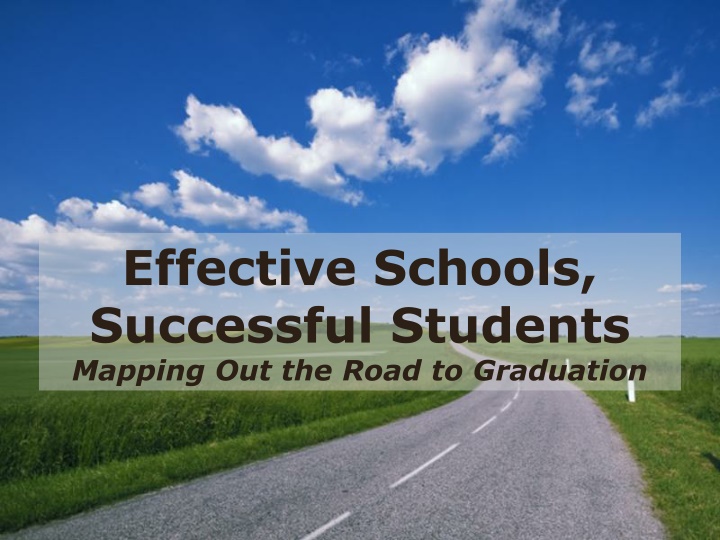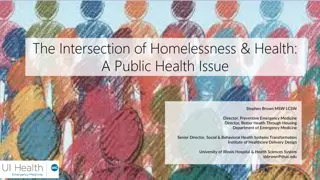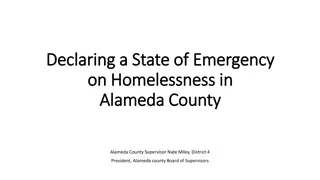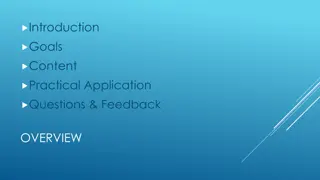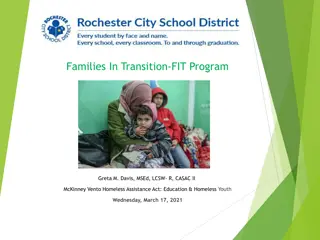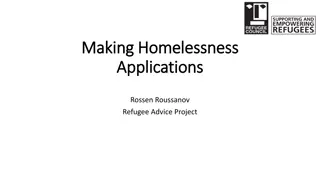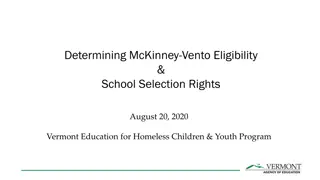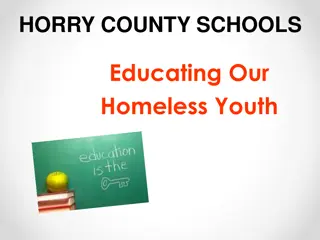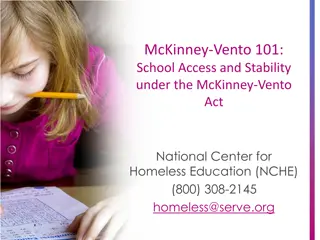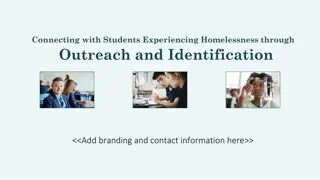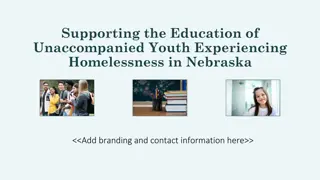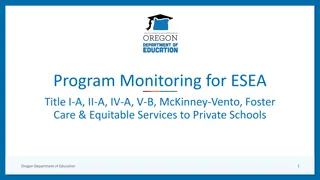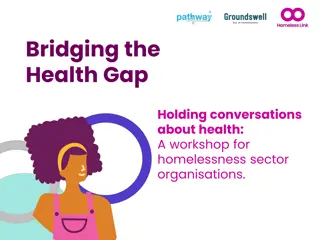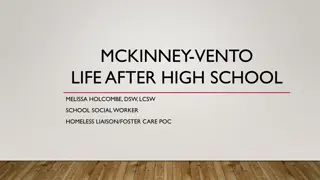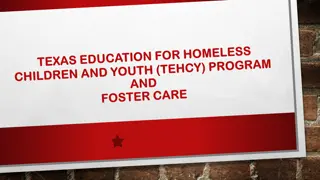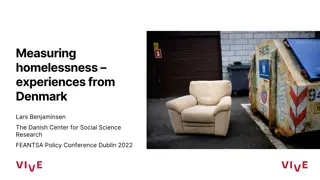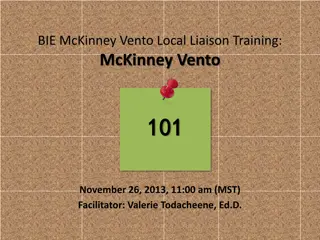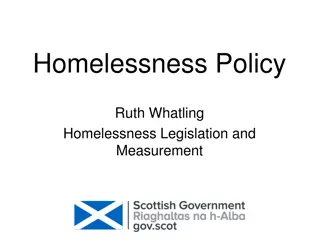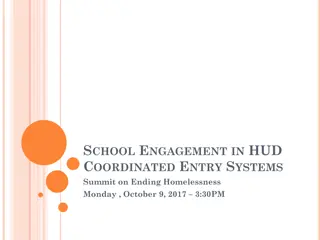Impact of Homelessness on Education & McKinney-Vento Act
Explore the educational impact of homelessness on students, including behavioral issues, academic challenges, and support under the McKinney-Vento Act. Learn about identifying, enrolling, and providing equal opportunities for homeless children & youth.
Download Presentation

Please find below an Image/Link to download the presentation.
The content on the website is provided AS IS for your information and personal use only. It may not be sold, licensed, or shared on other websites without obtaining consent from the author.If you encounter any issues during the download, it is possible that the publisher has removed the file from their server.
You are allowed to download the files provided on this website for personal or commercial use, subject to the condition that they are used lawfully. All files are the property of their respective owners.
The content on the website is provided AS IS for your information and personal use only. It may not be sold, licensed, or shared on other websites without obtaining consent from the author.
E N D
Presentation Transcript
Effective Schools, Successful Students Mapping Out the Road to Graduation
Session Objectives Understand the impact of homelessness on the education of homeless children & youth (HCY) Become familiar with data requirements related to serving HCY Identify key areas of implementation for review Become familiar with NCHE s needs assessment tool Spend time applying what we discuss
Educational Impact of Homelessness Effects of trauma may show as behavioral problems Poor concentration due to hunger, sleeplessness, or health issues Hoarding food or other items Inappropriate placement in classes due to records delays Delays in services like special education Suspensions or expulsions due to inadequate Individualized Education Programs (IEPs)
Educational Impact of Homelessness Behavior issues due to not having school supplies or clothes Low grades due to not having space or supplies for homework Poor attendance due to not having adequate living space or difficulties accessing transportation Low credit accrual Poor parent involvement with school
McKinney-Vento (MV) Act Purpose Ensure that each homeless child & youth has equal access to the same free, appropriate public education as provided to other children & youth Key focus areas Enrollment Attendance Success
MV Requires LEAs to Identify HCY thru coordination between school personnel & other agencies Enroll HCY & provide full & equal opportunity for them to succeed Provide educational services to HCY, including public preschool programs Inform parents or guardians of educational & related opportunities available to their children
MV Requires LEAs to Post public notice of educational rights for HCY Mediate disputes Inform parents, guardians, & unaccompanied homeless youth (UHY) about transportation services & provide the services Revise policies to remove enrollment barriers Collect data, as required by the Secretary of Education
MV Data Requirements Number of HCY enrolled in each grade Number of HCY staying in each type of nighttime residence Number of HCY in subgroups UHY, Limited English Proficient, Receiving Special Education or Migrant Education Number of HCY served by grants For each grade & in each subgroup Academic performance for each testing area
Other Data Requirements Number of HCY served by Title I Number of HCY who dropout for each grade
Implementation Challenges Limited funding from MV How to fund liaison, other staff, transportation, other services Time Liaisons usually have multiple program areas Influence MV often not viewed as high priority Liaisons can t always change policy directly Can just be overwhelming
Every system is perfectly designed to get the results it gets. --Paul Batalden, MD, Senior Fellow, Institute for Healthcare Improvement
Needs Assessments Allow LEAs to Understand the uniqueness of your students Identify areas where improvement is needed Prioritize activities to get the greatest return on investment Create a process for reviewing data & documents Communicate needs with evidence & authority
NCHEs Needs Assessment Tool Focus on 5 key areas from MV 1. Awareness 2. Policies/Procedures 3. Identification, Enrollment, & Access 4. Student Success 5. Collaboration Each section includes guiding questions, space for notes, & summary information
Focus Area: Awareness Knowledge of The MV homeless definition Educational rights & services available Roles: who identifies HCY, makes referrals, mediates disputes, etc. Steps to take when a student is identified
Awareness: Good Questions How often do school staff participate in trainings? How do you know the training improved their ability to implement the law? How do instructional & behavioral approaches reflect an understanding of the needs of homeless students, including trauma-informed care? How many referrals do you receive as a result of posters or similar public notice of educational rights of homeless students? Do others in your building use them as a resource? If no, why not?
Focus Area: Policies/Procedures Simple procedures to identify homeless students, enroll them immediately, & link them to services Policies for maintaining confidentiality of homeless students (not just FERPA) System for routine communication with the LEA liaison A MV dispute process including a quick way to provide written notice to parents, guardians, or UHY
Policies/Procedures: Good Questions How easy is it for a HCY to enroll in your district? To request services like transportation? Who communicates with the liaison? How often? Is it for emergencies only, training only, or something else?
Policies/Procedures: Good Questions How do you know staff are familiar with procedures for enrolling HCY & linking them to services? How do they convey that information to others? How easy is it for a student or family to request a dispute mediation? How does the LEA ensure they understand the process and make referrals to the liaison? What are disputes focused on? What steps do school personnel take to maintain confidentiality of homeless students & families? How is that communicated to staff?
Focus Needs: Identification To identify all students experiencing homelessness To dispel myths & fears regarding identification to ensure homeless families & youth willingly self-identify themselves & are identified by staff even when they don t To provide preschool-aged homeless children services
Identification: Good Questions Does the number of HCY identified by your LEA align with poverty in your community (e.g., children eligible for free meals or Title I services)? How faithfully does your district use a residency questionnaire? How accurate is the questionnaire in identifying HCY?
Identification: Good Questions How do registrars & social workers discuss living situations with families & youth? Services that are available as a result of homelessness? Are there procedures for referring a homeless family with a preschool-aged child to services? Who makes the referrals? In what ways do staff demonstrate an understanding of signs that a student may be homeless? The importance of identifying students?
Focus Area: Enrollment Students must be enrolled immediately, even without records, documentation of their living situation, & similar UHY must be enrolled immediately, even without a guardian or parent Students must not experience a disruption to enrollment once identified as homeless
Enrollment: Good Questions How long does it take HCY to enroll in school? How long does it take UHY to enroll in school? What issues delay enrollment? Are delays districtwide or limited to particular buildings or situations? Do staff appropriately contact the liaison for help with enrolling students?
Focus Area: Access Schools must link HCY to services, such as transportation, school meals, academic support, & extracurricular activities Barriers, such as fees & parent signatures, must not prevent HCY from participating in school activities like field trips & extracurricular activities
Access: Good Questions What causes delays for HCY in receiving transportation, school meals, or academic support? How long are they? How often are fees waived for field trips & extracurricular activities? What evidence is there that staff know how to take to request a waiver? What evidence suggests policies that allow UHY to access school activities are working?
Focus Area: Student Success HCY need student services & other supports to help them perform well, despite stress, mobility, & absences HCY need ways to gain credits quickly LEAs need trauma informed discipline policies that take into account conditions beyond student control to ensure appropriate consequences are given instead of punishments for being homeless LEAs need ways to track special education needs of HCY & expedite evaluations to ensure timely provision of services
Student Success: Good Questions How do assessment scores of HCY in your school compare with LEA averages? With other subpopulations of students? What is the attendance rate of HCY compared to the LEA average? What reasons are given by HCY for irregular attendance? What academic support does your school provide to HCY? How do you know the supports are working? What student services or community referrals does your school provide to address the trauma & basic needs of HCY?
Student Success: Good Questions How are homeless youth allowed to accumulate or make up credits? How many HCY graduate late or drop out due to lack of credits? How long do homeless students wait to receive special education services? How do you know the services are effectively meeting student needs? How does the suspension rate of HCY compare to the LEA average? Why do HCY receive suspensions or expulsions?
Focus Area: Collaboration LEAs must connect school programs to meet needs related to homelessness LEAs must connect to community resources to meet needs related to homelessness Collaboration should result in problem solving, resource sharing to meet HCY needs in concrete ways
Collaboration: Good Questions How does your staff discuss the needs of HCY & ways to meet them with school resources? How does your staff make referrals to community resources for homeless families who have unmet basic needs? Do families actually access them? How does your LEA partner with community agencies to meet needs & coordinate resources? How do you know it s working?
Expressing Need Which is the clearest statement of need? 1. Liaisons need more training on determining eligibility of homeless students. 2. The graduation rate for students identified as homeless in their senior year in my district needs to increase from 56% to at least the district average of 85% for all students. 3. We need more home visiting programs so preschool aged homeless children have ready access to learning opportunities when preschool programs are at capacity.
What is a Need? For planning purposes, needs express a gap between what is & what should be Specifies a specific group with the need Based on data that specifies the severity of the gap Is based on a comparison Suggests a specific outcome desired or goal to be achieved Planning & Conducting Needs Assessments: A Practical Guide Witkin & Altschuld, 1995
Need as a Gap, Not a Solution Allows consideration of root causes Allows consideration of a range of options, not just the one Facilitates the development of a measurable goal to achieve (outcome), rather than the completion of an activity (output) What you need to achieve, rather than what you need to do Describe where your program will be when the need is addressed
Now You Try Over the past three years, your MV program has been monitored each year. Two out of three years, your district received findings related to not conducting outreach activities to identify homeless children & youth, which resulted in under-identification. Write a need statement on the worksheet with the red star that expresses the gap between what is & what should be.
Finding Root Causes A need expresses a gap, but does not explain why the gap exists Most situations are the result of a number of contributing factors A strategy that addresses the wrong cause will not be effective
5 Whys 1. Identify a challenge Attendance of students identified as homeless is 30% lower than that of housed students 2. Ask why the challenge exists, develop hypotheses & confirm using data Districts often take over a week to set up transportation to the school of origin (parent complaints, monitoring findings) Homeless parents don t re-enroll students quickly after they move (withdrawal & enrollment records) 3. Ask why 5 times
Really? 5 Times? To explore all the factors contributing to a challenge May not really need to do this five times Stop when reach a level of contributing factors over which you have no control or for which you could not create a related program strategy Because homeless education is not a legislative priority Because of global warming
Selecting Activities Are they related to the outcomes? Are they likely to address the identified need by reducing the gap between what is & what should be? Are they based in research or good practice? Are they appropriate for the context in your LEA? Is cost, training, required resources, etc., feasible? Can they supplement or be supplemented by existing programs?
Basics of Logic Model Thinking Needs are grounded in data and target a goal Important to find root causes Logical sequence to ultimate outcomes Alignment of all parts and if-then thinking Socially constructed
Resources McKinney-Vento Data Standards & Indicators center.serve.org/nche/downloads/st_and_ind_2006_rev.d oc Conducting Needs Assessments & Evaluating Services center.serve.org/nche/pr/na_eval.php Kellogg Foundation Logic Model Development Guide wkkf.org/resource-directory/resource/2006/02/wk-kellogg- foundation-logic-model-development-guide University of Wisconsin-Extension Program Development and Evaluation uwex.edu/ces/pdande/evaluation/evallogicmodel.html
